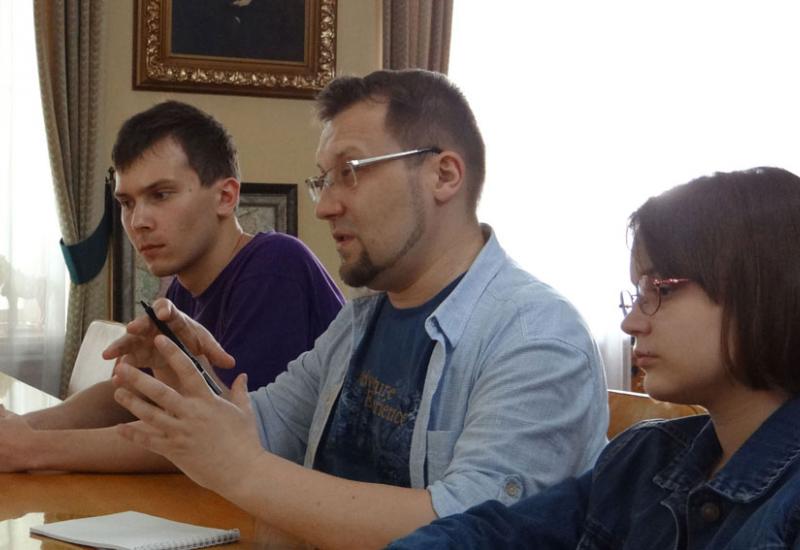The project of mars rover, or rather mars aircraft "Mars Hopper" developed in Ukraine won an international hackathon "NASA Space App Challenge". This is a competition, which is regularly held under the auspices of the National Aeronautics and Space Administration of USA (NASA) since 2012. This year 15,310 participants from 61 countries competed in NASA hackathon. They presented 1178 drafts. It was held for the first time in Ukraine. Domestic teams participated in the category "Selecting people" and one of them immediately won the victory!
The winners team consists of seven enthusiasts: Alexander Butkalyuk , Sophia Butkalyuk, Vyacheslav Osaulenko, Mykolai Denisenko, Paulo Pravdyukov, Andriy Muzichenko and Elijah Rubinskyy.
Three of them - Paulo Pravdyukov, Mykolai Denisenko and Vyacheslav Osaulenko - are the graduates of the National Technical University of Ukraine "Kyiv Polytechnic Institute" of various years. Vyacheslav Osaulenko, furthermore is now a postgraduate student of the Institute of Applied Systems Analysis of "KPI". Recently, another student of "KPI" Volodymyr Szymanski joined the team.
It is worth noting that the team members live in different cities. For the first time they met only at the "SpaceApps BootCamp" - training camp, which took place three weeks before the actual hackathon. There the organizers were determing the directions and the challenges for future contestants, which they have to solve during the innovators competition.
The developers of "Mars Hopper" offered to create a drone to study the polar caps of Mars and its environs. The principle of its action is disclosed in the title. The word "Hopper" translated to English means "jumper". This vehicle uses carbon dioxide CO2. As you know, under the strong cooling it becomes a snow-like mass, which is also called "dry ice". Such dry ice is found on the surface of the polar caps of the Red Planet. So during landing UAV (unmanned aerial vehicle) takes it for the next flight. The "Jumper" accumulats the energy of radioisotopes in carbon dioxide by heating, thereby changing its phase from a solid to a supercritical fluid. The modified CO2 is released into the atmosphere of Mars at a high speed and is used to generate reactive power in accelerators. With the help of which the aircraft is raised up. And after this its propellers begin to work and UAV overcomes a certain distance to the next landfall and gathering of carbon dioxide from the surface. Then another jump is made again, and everything starts from the begining.
The youngest team member Sofia Butkalyuk came up with the idea of using dry ice as the working fluid for Martian aircraft engines. She is only 11 years old and she is studying in sixth, to be more exact went on to the seventh form in lyceum in Vinnitsa. Developing this idea, the creators of this project analysed the possibility of its implementation using technologies that exist today and are already used in space projects. It turned that it is quite real to put it into practice. They had also held computered modeling of a flight process to visualize the project. Moreover, Alexander and Sofia Butkalyuk had even made and tested a prototype device that can fly using CO2. "We made everything the most easy for pressures to be low. We used simple household tools. We took ordinary plastic bottle as a receiver, further, because of this our colleagues were teasing us and they even called our design "Bottleaircraft". But we got a glide rocket of 122 grams, that can fly several meters using 3-4 grams of dry ice", - Alexander Butkalyuk reported at a meeting with scientists of "KPI".
Of course, during this meeting not only the winning of the "Mars Hopper" project and the problems they had to overcome on the way to it were discussed. It was about the further work on the project, prototyping and testing them of course in the earth environment. While talking even a small dispute about the aerodynamic characteristics of the design while flying in conditions of extremely rarefied compared to Earth Mars atmosphere appeared. But all unanimously admited the idea, inherent in the development of "Jumper", to be extremely productive. Therefore, the authors were invited to carry out further work in innovative environment of university "Sikorsky Challenge". "KPI" has all the conditions for that. And you can not just work in the prototyping laboratory, but you also can get investments from venture funds and, if necessary to consult scientists and engineers that have many years working in various scientific fields related to space and aviation themes.

